Things to do in The Romantic Road
The Romantic Road was a trade route during the middle ages and has retained its historic appeal. The well-trodden tourist track winds through lovely countryside, fortified medieval towns and picturesque old villages. Attractions along the Romantic Road include the ancient walls, gates and guard towers of the villages, Gothic cathedrals and fairytale fortresses, half-timbered houses, historic hotels and even medieval festivals.
There are many famous places to visit along the Romantic Road. Augsburg, the route's largest city and one of the oldest in Germany, offers visitors the chance to explore 2,000 years of history. Dinkelsbühl, still protected by 16 towers and 10th-century walls, is full of cobbled streets and 16th-century houses. Rothenburg, known to be the best-preserved medieval town in Germany, has fortifications and other buildings dating back to the 13th century, while Wurzburg is a lively little town with a hundred churches and a UNESCO-listed Residential Palace.
There are a number of delightful castles and fortresses to be discovered along the route, which is often simply called the German Castle Road. Some of the highlights for castle enthusiasts are the Burg Harburg Castle; the 1,000-year-old Castle Hotel of Colmberg, where visitors can spend the night; the Heidelberg Castle in the charming town of the same name; the three castle ruins of Eberbach; Langenburg Castle; and the famous Neuschwanstein. Neuschwanstein is one of the most famous castles in the world and marks the end of the Romantic Road. The interiors are as rich and magical as the facade and definitely worth investigating.
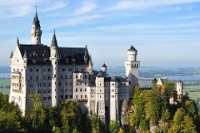
Neuschwanstein Castle
Neuschwanstein Castle was built by Mad King Ludwig II and has become a Bavarian trademark, with its pale Gothic facade rising from a green hill. Day tours from Munich travel to the…
Neuschwanstein Castle
Neuschwanstein Castle was built by Mad King Ludwig II and has become a Bavarian trademark, with its pale Gothic facade rising from a green hill. Day tours from Munich travel to the castle and visitors also drive from Garmisch. From the parking lot there is a steep half-mile (1km) climb to the fairytale fortress, with indulgent guests preferring a horse-drawn carriage ride to the gates. The interior is extravagant, particularly the king's apartments, which are decorated entirely with hand-embroidered silk, carvings and elaborate wall and ceiling paintings. The rooms can only be visited as part of a guided tour and no photography or filming is allowed in the castle.
Website www.neuschwanstein.com
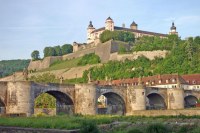
Würzburg
A popular starting point for the Romantic Road, Würzburg is nestled in a picturesque location in the heart of the Franconian wine region of rolling hills, pretty vineyards. Famous…
Würzburg
A popular starting point for the Romantic Road, Würzburg is nestled in a picturesque location in the heart of the Franconian wine region of rolling hills, pretty vineyards. Famous for its 100 churches and the Residential Palace, the city's architecture is composed heavily of baroque and rococo pieces and are best viewed from the Alte Mainbrucke, an old pedestrian bridge. The 12th-century Marienburg Fortress sports lovely gardens and a museum, and travellers adore the Würzburger Cathedral, one of the largest Romanesque churches in Germany. Würzburg is far from quiet and sleepy, as its student population maintains a vibrant nightlife, and colourful wine festivals add to the appeal.
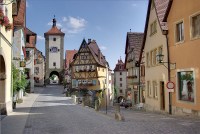
Rothenburg
Known as the best-preserved medieval town in Germany, Rothenburg is an absolute must see for anyone travelling on the Romantic Road. The 13th-century fortified walls are undamaged,…
Rothenburg
Known as the best-preserved medieval town in Germany, Rothenburg is an absolute must see for anyone travelling on the Romantic Road. The 13th-century fortified walls are undamaged, encircling a quaint city centre with a number of charming buildings and fascinating museums. Enjoying stunning views from the top of the Town Hall tower or exploring the old walls are great ways to gauge the look and feel of this fairytale cityscape. The Medieval Crime Museum is a popular excursion with visitors, while the Lutheran church of St Jakob is also a must for those interested in medieval art and architecture, its wood carvings and stained-glass windows dating back to the 14th century. After a day out on the ramparts, the town's walled garden is a lovely place to stroll, relax or picnic.
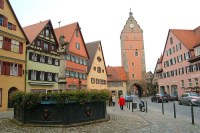
Dinkelsbühl
A less-crowded alternative to Rothenburg, Dinkelsbühl is a scenic medieval town on the Romantic Road. Surrounded by 16 towers along fortified 10th-century walls, the town centre i…
Dinkelsbühl
A less-crowded alternative to Rothenburg, Dinkelsbühl is a scenic medieval town on the Romantic Road. Surrounded by 16 towers along fortified 10th-century walls, the town centre is lined with picturesque 16th-century houses, churches and a few enthralling historical museums. Leisurely strolls or bike rides along the perimeter of the fortified old town are great ways to get to grips with its charming secrets. One of the main highlights of Dinkelsbühl is the massive 15th-century Parish Church of Saint George, where entry is free and a quick climb up the tower affords amazing views. And lastly, no visit to Dinkelsbühl is complete without sampling the gingerbread, a local speciality.
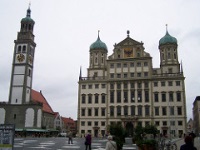
Augsburg
The largest city along the Romantic Road, picturesque and traditional Augsburg is also among the oldest cities in Germany with a history stretching back 2,000 years. It boasts many…
Augsburg
The largest city along the Romantic Road, picturesque and traditional Augsburg is also among the oldest cities in Germany with a history stretching back 2,000 years. It boasts many interesting buildings, including several ornately decorated churches and Baroque houses. Some of the city's most impressive old architecture includes the 9th-century cathedral, the 1620 town hall, the Perlachturm bell tower built in 989, and the Schaezlerpalais, which is a mansion dating back to 1765. Other popular tourist attractions in Augsburg include the Puppet Theatre and Museum, the zoo and the botanical garden. Known for its traditional German restaurants, it's a popular stop both on the Romantic Road and on journeys to the Bavarian Alps in the south.



